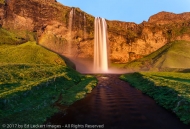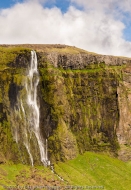


One of my favorite types of photography that I don’t do enough of is abstracts. Webster defines an abstract of the art variety as “expressing ideas and emotions by using elements such as colors and lines without attempting to create a realistic picture”. I define it as “if it’s in focus and you still can’t tell what it is, it’s an abstract”.
Abstracts can be some of the easiest images to find, once you know how to look for them. And you don’t even have to leave your house to find them. A good macro lens or something equivalent that helps you focus really really close is all you need. For example, what do you think this is? I call it “Woven Abstract”. It’s one that Getty Images selected from my collection to license on their site.
Well, it seems I had this trash can hanging around that I thought looked pretty cool, so I got up really close and found a pattern I liked and grabbed a couple of shots. That’s the key, though – finding a pattern. You can’t just stick your camera up close to something, fire away and hope for the best. You have to spend some time finding the right composition.
When I was attending a photo workshop in the Provence region of France a few years ago, we traveled to Cassis on the Mediterranean coast one day to do a shoot. While we were on the docks near some fishing boats, I noticed a guy in our class standing over some nets, firing away with his camera, handheld (without a tripod). As soon as he moved out of the way (and trust me, once I saw what he was shooting he couldn’t get out of the way fast enough), I headed over and set up my tripod above the nets and started looking for interesting patterns. One of the reasons I use a tripod is that it forces me to slow down and think about my composition more. It also allows me to keep the camera in position once I’ve found a possible composition, and lets me make small incremental changes until I’m satisfied. That’s much harder to do when shooting handheld.
The next afternoon we were asked to submit our favorite shots for critique by the instructor, and sure enough the guy on the dock chose a fishing net image, and so did I. His work was reviewed first, and the instructor was not impressed. He specifically called him out for not finding any interesting patterns in a subject that obviously had a lot of potential. I sure was glad I had taken the time to carefully set up my shot – I hate getting chewed out in front of the class! Anyway, can you find the treble clef in this image? How about the (almost) upside down bass clef? And by the way, I did not touch the nets! This is exactly how I found them. Not that there’s anything wrong with arranging the subject the way you want it. You’d be amazed at how insanely furious some photographers get at the mere suggestion of arranging or improving a subject in any way. I’m not sure where they get these crazy notions, but I’ve personally seen people like that, so I know they exist.
Anyway, shooting abstracts can be fun, and in looking for them you’ll start to see things you never would have noticed otherwise. Whether you find them in your living room, in the grass in the back yard, on the beach, or in Death Valley next to the sand dunes, there’s a whole world of abstracts out there, waiting to be found!
